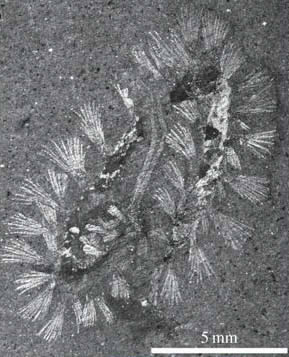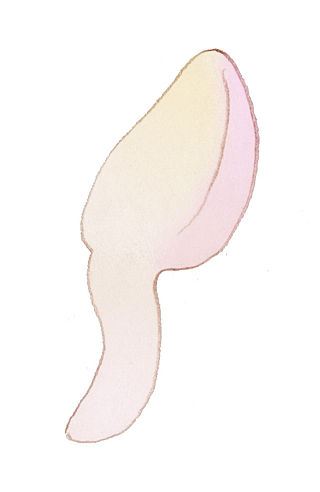
Ctenorhabdotus capulus is an extinct species of ctenophore, known from the Burgess shale in British Columbia, Canada. It is approximately 515 to 505 million years old and was equipped with 24 comb rows, three times as many as known from modern ctenophores. 5 specimens of Ctenorhabdotus are known from the Greater Phyllopod bed, where they comprise < 0.1% of the community.

Kootenia is a genus of trilobites of the family Dorypygidae. 118 specimens of Kootenia are known from the Greater Phyllopod bed, where they comprise 0.22% of the community. Its major characteristics are that of the closely related Olenoides, including medium size, a large glabella, and a medium-sized pygidium, but also a lack of the strong interpleural furrows on the pygidium that Olenoides has.

Burgessochaeta is an extinct genus of polychaete annelids from the Middle Cambrian. Its fossils have been found in the Burgess Shale in British Columbia, Canada. A total of 189 specimens of Burgessochaeta are known from the Greater Phyllopod bed, where they comprise 0.36% of the community. Specimens have also been found at Marble Canyon. The genus was described by Conway Morris (1979) and re-examined by Eibye-Jacobsen (2004).

Morania is a genus of cyanobacterium preserved as carbonaceous films in the Middle Cambrian Burgess Shale. it is present throughout the shale; 2580 specimens of Morania are known from the Greater Phyllopod bed, where they comprise 4.90% of the community. It is filamentous, forms sheets, and resembles the modern cyanobacterium Nostoc. It would have had a role in binding the sediment, and would have been a food source for such organisms as Odontogriphus and Wiwaxia.
The Phyllopod bed, designated by USNM locality number 35k, is the most famous fossil-bearing member of the Burgess Shale fossil Lagerstätte. It was quarried by Charles Walcott from 1911–1917, and was the source of 95% of the fossils he collected during this time; tens of thousands of soft-bodied fossils representing over 150 genera have been recovered from the Phyllopod bed alone.
Chaunograptus is a genus of putative graptolite known from the Middle Cambrian Burgess Shale. 11 specimens of Chaunograptus are known from the Greater Phyllopod bed, where they comprise 0.02% of the community.
Bosworthia is a genus of branching photosynthetic alga known from the Middle Cambrian Burgess Shale. 20 specimens of Bosworthia are known from the Greater Phyllopod bed, where they comprise 0.04% of the community. One of its two original species has since been reassigned to Walcottophycus.
Ehmaniella is a genus of trilobite known from the Middle Cambrian Burgess Shale. 392 specimens of Ehmaniella are known from the Greater Phyllopod bed, where they comprise 0.74% of the community.

Falospongia is a genus of sponge made up of radiating fronds, known from the Middle Cambrian Burgess Shale. Its name is derived from the Latin fala ("scaffold") and spongia ("sponge"), referring to the open framework of the skeleton. It superficially resembles Haplistion but is monaxial. 5 specimens of Falospongia are known from the Greater Phyllopod bed, where they comprise under 0.1% of the community.
Fieldospongia is a genus of sea sponge known from the Middle Cambrian Burgess Shale. Just five specimens of Fieldospongia are known from the Greater Phyllopod bed, where they comprise less than 0.1% of the community.
Mackenzia is an elongated bag-like animal known from the Middle Cambrian Burgess Shale. It attached directly to hard surfaces, such as brachiopod shells. 14 specimens of Mackenzia are known from the Greater Phyllopod bed, where they comprise <0.1% of the community. Mackenzia was originally described by Charles Walcott in 1911 as a holothurian echinoderm. Later, Mackenzia is thought to be a cnidarian and appears most similar to modern sea anemones.

Micromitra is a genus of brachiopods known from the Middle Cambrian Burgess Shale. 160 specimens of Micromitra are known from the Greater Phyllopod bed, where they comprise 0.3% of the community.
Paterina is a genus of brachiopods known from the Middle Cambrian Burgess Shale. 18 specimens of Paterina are known from the Greater Phyllopod bed, where they comprise 0.03% of the community.
Peronochaeta is a genus of annelid known from the Middle Cambrian Burgess Shale. 19 specimens of Peronochaeta are known from the Greater Phyllopod bed, where they comprise < 0.1% of the community. The genus was described by Conway Morris (1979) and re-examined by Eibye-Jacobsen (2004).

Pirania is an extinct genus of sea sponge known from the Middle Cambrian Burgess Shale and the Ordovician Fezouata formation. It is named after Mount St. Piran, a mountain situated in the Bow River Valley in Banff National Park, Alberta. It was first described in 1920 by Charles Doolittle Walcott. 198 specimens of Pirania are known from the Greater Phyllopod bed, where they comprise 0.38% of the community.

Oryctocephalus is a genus of trilobite known from the Middle Cambrian Burgess Shale. 24 specimens of Oryctocephalus are known from the Greater Phyllopod bed, where they comprise 0.42% of the community. This small- to medium-sized trilobite's major characteristics are prominent eye ridges, pleural spines, long genal spines, spines on the pygidium, and notably four furrows connecting pairs of pits on its glabella. Juvenile specimens have been found with only 5 or 6 thoracic segments and about one eighth of adult size, as well as about 2 mm wide.

Priscansermarinus barnetti is an organism known from the Middle Cambrian Burgess Shale which was originally interpreted as a species of lepadomorph barnacle. Four specimens of P. barnetti are known from the Greater Phyllopod bed. A reflective area originally interpreted as external plates has been reinterpreted as a more complex structure inside the body; Derek Briggs, a leading authority on the arthropods of the Burgess Shale, has questioned its assignment as a barnacle or even an arthropod. The World Register of Marine Species places Priscansermarinus in Multicrustacea without assigning a class or order.
Wapkia is an extinct genus of sea sponge with radial sclerites, known from the Middle Cambrian Burgess Shale. It was first described in 1920 by Charles Doolittle Walcott. 32 specimens of Wapkia are known from the Greater Phyllopod bed, where they comprise 0.06% of the community.
Wahpia is a genus of alga known from the Middle Cambrian Burgess Shale. 33 specimens of Wahpia are known from the Greater Phyllopod bed, where they comprise 0.06% of the community.

Diagoniella is a genus of sponge known from the Middle Cambrian Burgess Shale. 128 specimens of Diagoniella are known from the Greater Phyllopod bed, where they comprise 0.24% of the community.









